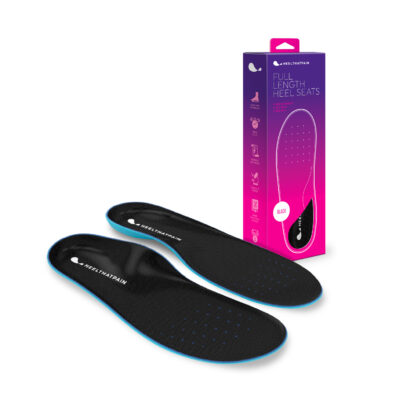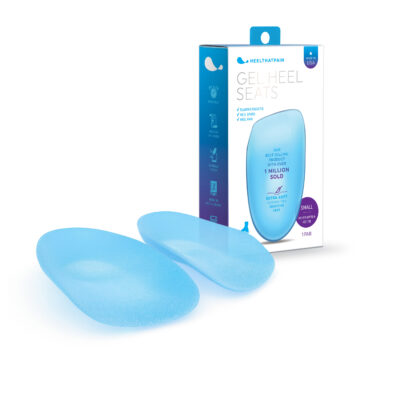Corticosteroid Injections for Heel Pain & Plantar Fasciitis
While most cases of plantar fasciitis can be effectively resolved with inexpensive, at-home treatment options like orthotic inserts, heel stretches, rest, and icing, there is no such thing as a one-size-fits-all treatment plan for every arch!
Corticosteroid injections, also known as cortisone injections or steroid injections, are commonly used to relieve the pain and inflammation of plantar fasciitis, especially in cases of chronic pain.
How do corticosteroid injections work to relieve heel pain? What should you know before you decide to get a cortisone injection? Are there any risks? And, most importantly, how well do steroid injections work?
How Do Cortisone Injections Work?
Cortisone is a hormone that’s produced by your body’s adrenal glands in response to stress, allergic reactions, and inflammation.
Cortisone injections use a synthetic version of natural cortisone (also called a corticosteroid) to combat inflammation in very specific parts of the body, like the heels. It can be helpful to think of cortisone injections as a very targeted, potent version of tylenol or ibuprofen.
Steroid injections for plantar fasciitis are usually injected in the spot where the pain is most severe, using a thin needle. The injection itself is mildly painful, and your doctor will usually add a numbing agent to the cortisone shot itself, or numb the area prior to injecting you.
Your doctor will typically inject you on the inner part of your foot, rather than the heel itself to avoid damaging your fat pad, and avoid the small risk of plantar rupture (more on that below!).
Expect to spend some time resting your feet over the following 2-3 days (try to avoid exercise during this recovery period). And don’t be too alarmed if the pain gets slightly worse before it gets better. After day three, you should feel significant pain relief for about 3 months.
How Much Do Cortisone Shots Cost?
You can expect to pay anywhere from $50-$300 per injection, depending on your healthcare provider and your insurance coverage. While these costs are certainly less than surgical interventions, the expense of getting a cortisone shot every three months can really add up over time.
If your plantar pain comes back with a vengeance every three months, and your continued use of orthotic inserts, stretching, rest, and a night splint aren’t helping, you may need to consider other effective medical interventions or surgery.
Are Corticosteroid Injections Effective for Heel Pain?
In a word, yes! There’s a reason that cortisone injections are a go-to for severe and chronic pain from plantar fasciitis. This powerful anti-inflammatory shot can make a big difference in the level of pain you feel for about three months.
A 36-month clinical study conducted by Dr. Meriç Uğurlar and colleagues showed that corticosteroid injections were more effective than extracorporeal shock wave therapy (ESWT), prolotherapy, and platelet-rich plasma therapy. However, at the 36-month follow-up, the cortisone injection had completely lost any effectiveness.
If your plantar fasciitis isn’t responding to conservative treatment methods after 6-9 months, a cortisone shot can be an effective way to manage your pain without the expense and recovery time of surgery.
Just remember that steroid injections are a pain-management tool–not a cure! These shots will help lower inflammation and pain, but they won’t repair a damaged arch. Help repair your damaged plantar fascia by continuing to wear orthotic inserts that realign your arch and re-cushion your heel, stretching to strengthen and improve flexibility of the arch and surrounding muscles, and rest and ice your feet as needed.
Possible Risks of Steroid Injections
Like most medical procedures, there are a few rare side effects that you should be aware of before you decide to get a cortisone shot for plantar fasciitis.
One especially important side effect you should know about is something called a “cortisone flare.” This is pain that can flare up (and may actually feel even worse than your prior pain level) in the days right after your procedure. Cortisone flares happen for about 30% of patients, and if you’re one of them you can take heart knowing that the pain will go away after about 72 hours, and then improve drastically. Some patients may also notice some loss of skin pigmentation at the injection site.
Less common risk factors include plantar rupture (estimated in a study by Dr. Sameer Kapasi, MD and Dr. Yusuf Ziya Tatli on corticosteroid injections at between 1% and 10% of patients), and infection or heel pad deterioration. To avoid the risk of plantar rupture, your doctor will inject you on the side of your heel, rather than directly underneath it.
Treatments to Try Prior to Corticosteroid Injections
Corticosteroid injections can provide much-needed pain relief for many patients, especially in cases of very severe or chronic plantar fasciitis. However, most doctors recommend waiting to try cortisone shots until after more conservative methods have been exhausted for 6-9 months, because of the risk, recovery time, and expense involved. Before you try cortisone shots, make sure you’ve spent enough time trying these proven conservative treatment methods:
- Supportive shoes with a thick, cushioned sole that won’t further aggravate your condition (be sure to avoid flip-flops and walking barefoot whenever possible!)
- Weight loss, when possible, to reduce the impact and force your feet are required to absorb
- Orthotic inserts that lift the arch to an optimal height and re-cushion the heel fat pad
- Gentle, daily stretches to improve flexibility and strength in your arch, ankle, toes, and legs
- Icing to reduce inflammation, swelling, and pain
- Wear a Sock Night Splint while you sleep or rest, to keep your foot flexed in a gentle stretch all night long, which improves morning pain
- As needed, use NSAIDs (nonsteroidal anti-inflammatory) medication like Tylenol or Ibuprofen
If you decide that cortisone injections are right for you, make sure you continue using these proven conservative remedies to support and cushion your arch and help your heel fat pad recover. A multifaceted treatment approach is often the key to recovering from this frustrating and painful condition. But with a little perseverance and evidence-based treatments, most people who suffer from plantar fasciitis are back on their feet within a few months.
Articles Recommended for You:
Quick Plantar Fasciitis Treatments






